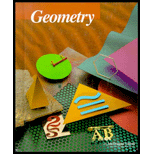
Concept explainers
(a)
To find: The ratio of area of shaded
(a)
Answer to Problem 20WE
The ratio of area of shaded circles is
Explanation of Solution
Given information:
The givenfigure is shown below.
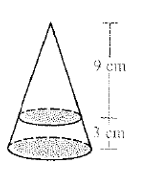
Calculation:
Let’s the area of middle circle is
Therefore,the ratio of area of shaded circles is
(b)
To find: The ratio of lateral area of the top part of the cone to the lateral area of whole cone.
(b)
Answer to Problem 20WE
The ratio of lateral area of the top part of the cone to the lateral area of whole cone is
Explanation of Solution
Given information:
The given figure is shown below.
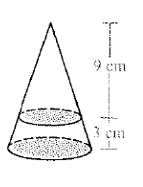
Calculation:
The lateral area of cone in terms of radius and slant height is
Consider the lateral area of cone is
Both the cones are similar so, ratio of radius and slant height would be similar.
The ratio of lateral area of the top part of the cone to the lateral area of whole cone.
Therefore, the ratio of lateral area of the top part of the cone to the lateral area of whole cone is
(c)
To find: The ratio of lateral area of the top part of the cone to the lateral area of bottom cone.
(c)
Answer to Problem 20WE
The ratio of lateral area of the top part of the cone to the lateral area of whole cone is
Explanation of Solution
Given information:
The given figure is shown below.
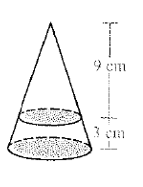
Calculation:
The lateral area of the bottom cone is the whole cone area minus the top cone area.
Therefore, the ratio of lateral area of the top part of the cone to the lateral area of bottom cone is
(d)
To find: The ratio of the volume of the top part of the cone to the volume of wholecone.
(d)
Answer to Problem 20WE
The ratio of the volume of the top part of the cone to the volume of whole cone is
Explanation of Solution
Given information:
The given figure is shown below.
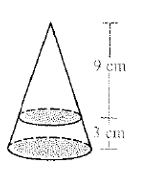
Calculation:
The volume of cone in terms of radius and slant height is
Both the cone is similar.Consider the volume of cone is
The ratio of the volume of the top part of the cone is to the volume of whole cone.
Therefore, the ratio of the volume of the top part of the cone to the volume of whole cone is
(e)
To find: The ratio of the volume of the top part of the cone to the volume of bottom cone.
(e)
Answer to Problem 20WE
The ratio of the volume of the top part of the cone to the volume of bottom cone is
Explanation of Solution
Given information:
The given figure is shown below.
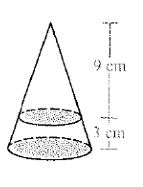
Calculation:
The ratio of the volume of the top part of the cone is to the volume of bottom cone.
Therefore, the ratio of the volume of the top part of the cone to the volume of bottom cone is
Chapter 12 Solutions
McDougal Littell Jurgensen Geometry: Student Edition Geometry
Additional Math Textbook Solutions
Thinking Mathematically (6th Edition)
Elementary Statistics: Picturing the World (7th Edition)
Pre-Algebra Student Edition
Elementary Statistics (13th Edition)
College Algebra (7th Edition)
Calculus for Business, Economics, Life Sciences, and Social Sciences (14th Edition)
- Find mSWarrow_forwardSelect all solids for which the formula V = Bh applies. A. a triangular prism B. a triangular pyramid C. a square pyramid D. a rectangular prism E. a cone F. a cylinderarrow_forwardThis is my h/w ,Required to find the region of shaded sector ,I don't really know how to deal with this tasks ,so if someone could help me to understand them it would be awesome,and sorry for my poor Englisharrow_forward
- △DEF△DEF has vertices D(0, 2) and F(6, 2). If △DEF△DEF has an area of 12 square units, select all the possible coordinates for E.arrow_forwardIn quadrilateral QRST, m<R=60, m<T=90, QR=RS, ST=8, TQ=8 How long is the longer diagonal of QRST? Find the ratio of RT to QS.arrow_forward13:26 ... ← Robert F. Blitzer - Thinkin... 0,04 61 KB/d 目 polygons to create a fraudulent tessellation with discrepancies that are too subtle for the eye to notice. In Exercises 45-46, you will use mathematics, not your eyes, to observe the irregularities. B A 45. Find the sum of the angle measures at vertex A. Then explain why the tessellation is a fake. 46. Find the sum of the angle measures at vertex B. Then explain why the tessellation is a fake. =et at If se Fic SECTION 10.3 Polygons, Perimeter, and Tessellations 645 61. I find it helpful to think of a polygon's perimeter as the length of its boundary. 62. If a polygon is not regular, I can determine the sum of the measures of its angles, but not the measure of any one of its angles. 63. I used floor tiles in the shape of regular pentagons to completely cover my kitchen floor. In Exercises 64-65, write an algebraic expression that represents the perimeter of the figure shown. is be 64. le a b C 2/ If se nyarrow_forward
- Schoology → C Cportsk12.com bookmarks Sis Grades and Attendance Al Detector - the Original Al Che X GPTZero + portsmouth.schoology.com/common-assessment-delivery/start/7747152192?action=onresume&submissionId=1600790102 New Tab Home | Schoology Quadrilateral Quiz English If WXYZ is a square, and WY = 32, find XY. Round your answer to the nearest tenth. Z XY = R X Y POSSIBLE POINTS: 5 2 of 20 48 21 1 2 345678910 Next ▸ Δ ㄖㄨ All Bookmarks Schoology Help Center | PRIVACY POLICY | Terms of Use PowerSchool ©2025arrow_forwardom nearest tenth if necessary. milsum 3. છે. 9.3mm 3mm A 78-43-92 4-3) 11.7 of 72.04-11.7-= lygons 7.8 mi 60.94 blants" 9 om 6. 4.15-7 16- 32m 1.8m 4.5m % ose 4.5m as to 65m 14 represents 5 square meters.arrow_forwardThe diagonals of rhombus ABCD intersect at E. Given that BAC=53 degrees, DE=8, and EC=6 find AEarrow_forward
- Volume of Dubai Cayan Towerarrow_forward1 B-P P+1+ 2-p 4-p min(Red)=? y=x² A (P,P')arrow_forwardMI P X /courses/segura10706/products/171960/pages/611?locale=&platformId=1030&lms=Y ☆ Finish Part I: Mathematics for Elementary and Middle School Teachers Continue in the app JJ 576 Chapter 12. Area of Shapes 9. Determine the area of the shaded shapes in Figure 12.48. Explain your reasoning. 1 unit S Figure 12.48 1 unit unit and the yarn for thearrow_forward
 Elementary Geometry For College Students, 7eGeometryISBN:9781337614085Author:Alexander, Daniel C.; Koeberlein, Geralyn M.Publisher:Cengage,
Elementary Geometry For College Students, 7eGeometryISBN:9781337614085Author:Alexander, Daniel C.; Koeberlein, Geralyn M.Publisher:Cengage, Elementary Geometry for College StudentsGeometryISBN:9781285195698Author:Daniel C. Alexander, Geralyn M. KoeberleinPublisher:Cengage Learning
Elementary Geometry for College StudentsGeometryISBN:9781285195698Author:Daniel C. Alexander, Geralyn M. KoeberleinPublisher:Cengage Learning

